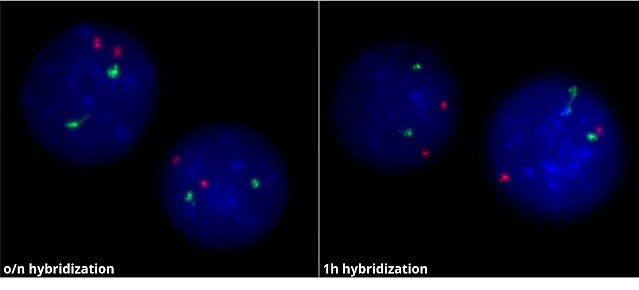Probes Newsletter 01/2019
Newsletter 01/2019

RapidHyb!
...demand more than excellent performance
Fluorescence in situ hybridization has become an essential detection assay in today´s routine diagnostics. However, long hybridization times of many hours to overnight are still a restrictive factor. We have refined the production process of our FISH probes to reduce background and artefacts and to improve the signal to noise ratio, particularly in short-time hybridization. Since mid-2015, one hour hybridization on lymphocytes is an integral part of quality control for all XCyting locus-specific probes at our manufacturing facility.

Our experience shows that short time hybridization can be successfully used in FISH assays following the recommended sample preparation and FISH protocol. No adaptions are necessary other than shortening the hybridization time. The image above of XL t(9;11) MLLT3/KMT2A DF captured during routine quality check shows overnight and short time hybridization of the same Lot in direct comparison. The signal intensity and background is similar, the information you can read from the image is identical.
Usually all locus-specific MetaSystems probes hybridized to lymphocytes are easily analyzed with hybridization times of one hour under optimal conditions. In case of weak signals or poor signal to noise ratio, hybridization time might be increased to 2-4h.

Cutoff values from overnight and one hour hybridizations on lymphocytes are comparable, indicating that MetaSystems XCyting locus-specific probes are suitable for short time hybridization on blood slides.
Please download the PDF fact sheet for more detailed information.


